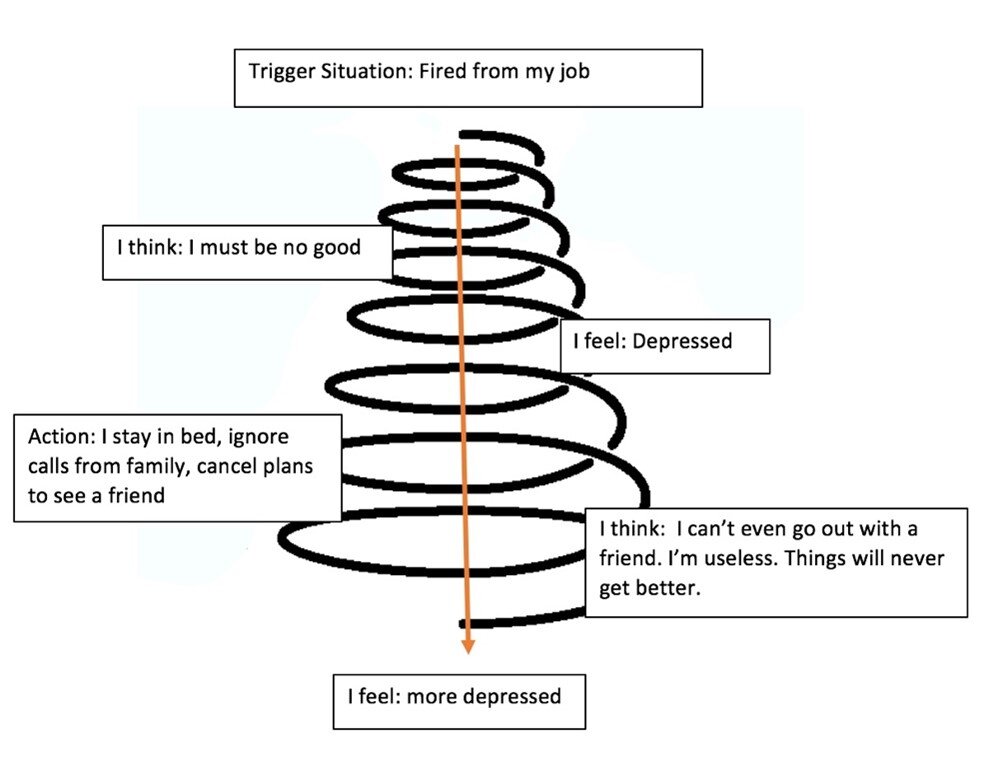Downward Mood Spirals in Depression
How we behave (what we do) when depressed can have a powerful impact on how we feel.
Often, when we feel depressed, our natural and automatic tendency is to withdraw from others and our broader world. This can be referred to as a mood-directed action tendency, or mood-directed behaviour: we feel depressed, and so we behave in a way that’s consistent with depression.
The problem with this is that when we withdraw we deprive ourselves of pleasant activities (those that give us a sense of achievement, closeness or enjoyment), and thus limit opportunities to change how we’re feeling. In addition, mood-directed behaviour in depression can strengthen the negative beliefs we have about ourselves and the situation, or result in new negative beliefs about ourselves and our situation, and this in turn can lead to even greater feelings of depression. When this happens, we find ourselves in a downward mood spiral.
Take a look at the example below (Figure 1). Mike* was fired from his job. He interpreted this to mean that he must be no good, which led to him feeling depressed, and consequentially he stayed in bed, withdrew from his family, and cancelled his plans to see a friend (mood-directed behaviour). This behaviour strengthened his belief that he’s no good because he couldn’t keep to his plans, and he started to think that his situation is never going to improve. He began to feel even more depressed than he was feeling earlier in the day.
Figure 1. Example downward mood spiral
The good news is, just like certain behaviours can make feelings of depression worse, other behaviours have the potential to improve feelings of depression.
If we perform behaviours that oppose mood-directed action tendencies when we feel depressed, we provide ourselves with an opportunity to change our perspective, and how we feel. Behaviours that oppose mood-directed action tendencies are sometimes referred to as goal-directed behaviours or “opposite actions”. Like the names suggest, this involves committing to scheduled activities that are in line with goals, or performing an action that is the opposite to what you feel like doing.
Referring to the example given above, perhaps if Mike went ahead with the plans he’d made with his friend, even though he was feeling depressed, he may have gained a different perspective about his situation, and consequentially felt differently. In other words, he may have created an upward mood spiral (Figure 2) rather than downward mood spiral.
Figure 2. Example Upward mood spiral
Understandably however, it’s not always easy to oppose the natural tendency to withdraw when feeling depressed. CBT Australia psychologists can help by providing you with evidence-based, cognitive-behavioural strategies to help get you out of a downward spiral, and prevent them from occurring in the future. This may include:
• Helping you to develop a greater understanding about your personal experience of depression and downward spirals
• Strategies to become more aware and mindful of your emotional state and associated thought processes
• Strategies to help you respond to situations more intentionally
• Strategies to reverse the downward spiral, e.g. activity scheduling
• Addressing obstacles to implementing intentional behaviours, such as beliefs about motivation and control
*Fictional example
Article written by Dr Monique Scott, Registered Psychologist, previously consulting from CBT Australia.



